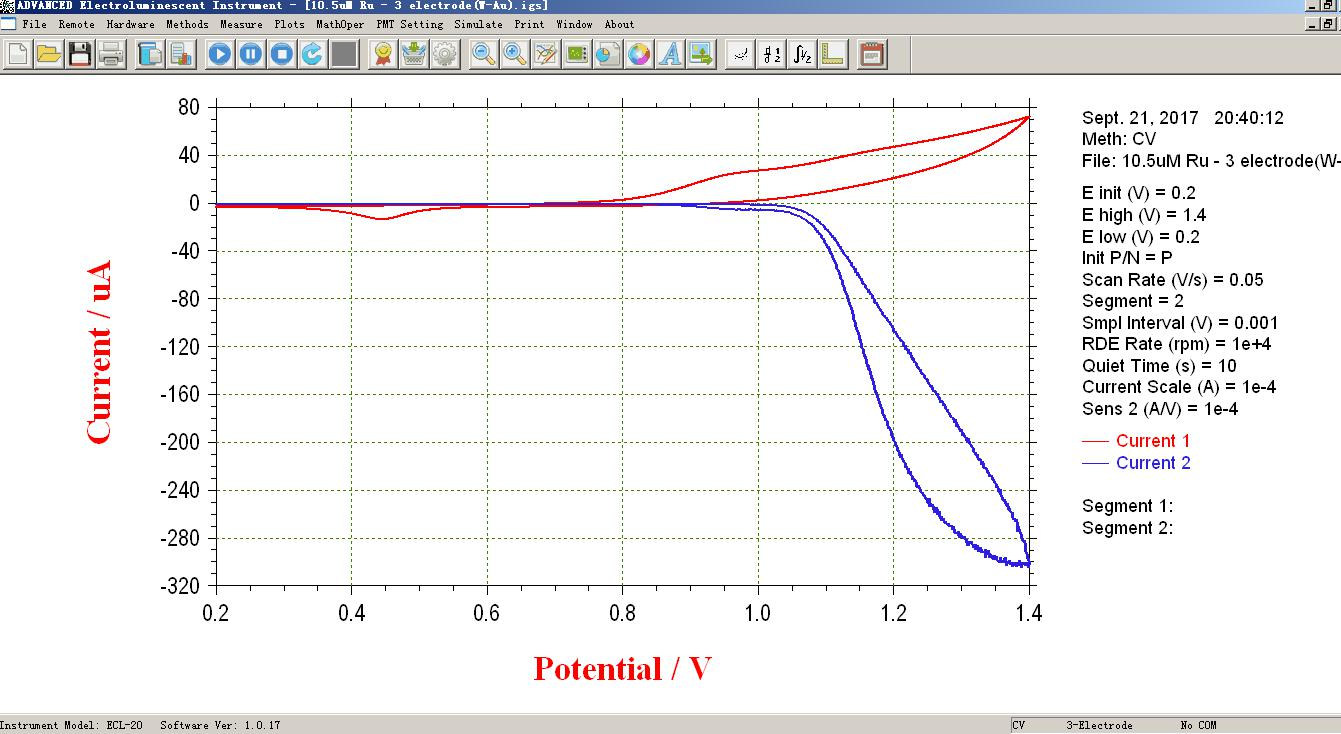ECL20 is computer controlled, fully automatic electrochemiluminescent instrument. The instrument uses the 16-bit DAC and 16-bit ADC for high resolution and accuracy. The system contains an advanced MCU for digital function generator with a high speed data acquisition circuit and a potentiostat. The compliance voltage is ±12 V, the output potential range is ±10 V and the current range is ±250 mA. The instrument is capable of measuring current down to 100 pA.
The data of the electrochemical and luminescent response are collected simultaneously. The software provides many powerful functions, such as straightforward file handling, extensive experimental control, flexible plots, various data analyses, and efficient digital simulation. Additional features include macro commands, working electrode conditioning, color, legend and font selection, data interpolation, visual baseline correction, data point removal, signal averaging and Fourier spectrum.
The instrument is powerful, automatic and affordable. It is particularly useful for electroluminescent applications.
Hardware Specification
Electroluminescent Instrument
Response of the PMT wavelength: 230-920 nm
PMT Activated Potential:5000-10000 mV
PMT Dark Current:<1 mV
Potentiostat and Galvanostat and AC Impedance
Maximum current: ±250 mA in 12 current scales
Compliance Voltage: ±12 V
Potentiostat rise time: < 1 μs, 0.8 μs typical
Output potential ranges: ±10 V
Potential resolution: 0.0015% of potential range
Potential accuracy: ±1 mV, ±0.01% of scale
Output potential noise: < 10 μV
Measured current range: ±10 pA to ±250 mA in 12 current scales
Measured current resolution: < 10 fA
Input bias current: < 50 pA
2- or 3- or 4-electrode configuration
Floating (isolated from earth) or earth ground (GND)
Galvanostat applied current range: 3 nA - 250 mA
Output current accuracy: 20 pA ±0.2% if > 3e-7A, ±1% otherwise
Output current resolution: 0.03% of applied current range
Measured potential range: ±0.025, ±0.1, ±0.25, ±1, ±2.5, ±10 V in 3 scales
Measured potential resolution: 0.0015% of measured range
Fast waveform update: 16-bit DAC at 10 MHz or 24-bit DAC at 1 MHz
Fast data acquisition: 16-bit ADC at 1 MHz
Reference electrode input impedance: 1x1012 ohm
Dimensions: 15.30” (W) x 9.50”(D) x 5.10”(H)
Weight: 4.2 kg for workstation and 1.5 kg for PMT cage
Electroluminescent techniques (9 methods)
Cyclic Voltammetry (CV),Linear Sweep Voltammetry (LSV),Chronoamperometry (CA),Differential Pulse Voltammetry (DPV),Normal Pulse Voltammetry (NPV),Square Wave Voltammetry (SWV),Amperometric i-t Curve (IT),Differential Pulse Amperometry (DPA) ,Triple Pulse Amperometry (TPA)
Electrochemical Techniques (30 methods)
Cyclic Voltammetry (CV),Linear Sweep Voltammetry (LSV),Staircase Voltammetry (SCV), Tafel Plot (TAFEL), Chronoamperometry (CA), Anson Plot (AP), Differential Pulse Voltammetry (DPV), Normal Pulse Voltammetry (NPV), Differential Normal Pulse Voltammetry (DNPV), Square Wave Voltammetry (SWV), AC Voltammetry (ACV), 2nd Harmonic AC Voltammetry (SHACV), Fourier Transform AC Voltammetry (FTACV), Amp, erometri, c i-t Curve (i-t), Differential Pulse Amperometry (DPA), Double Differential Pulse Amperometry (DDPA), Triple Pulse Amperometry (TPA), Integrated Pulse Amperometric Detection (IPAD), Bulk Electrolysis with Coulometry (BE), Hydrodynamic Modulation Voltammetry (HMV) , Sweep-Step Functions (SSF), Multi-Potential Steps (STEP), AC Impedance (IMP), Impedance - Time (IMPT), Impedance - Potential (IMPE), Chronopotentiometry (CP), Chronopotentiometry with Current Ramp (CPCR), Multi-Current Steps (ISTEP), Potentiometric Stripping Analysis (PSA), Electrochemical Noise Measurement (ECN), Open Circuit Potential - Time (OCPT)
Software Interface

Software Features for ECL20 Electroluminescent Instrument. The electrochemical and luminescent response are collected simultaneously. A typical three electrode system uses Au as working, 3.0 M KCl Ag/AgCl as reference and Pt as counter. The solution is 0.1 M PBS,0.1 M TPA,10.5 uM Ru(bpy)32+.Red line is the electrochemical signal while blue line is electroluminescent data.
|



